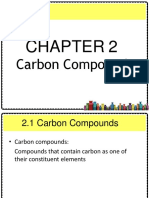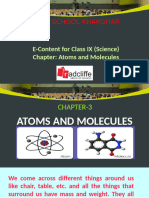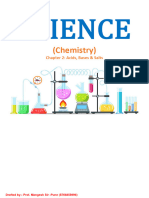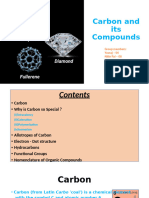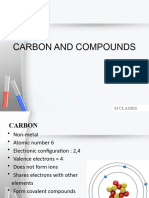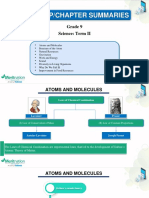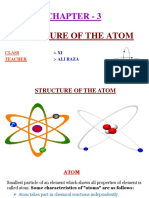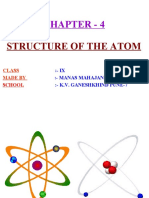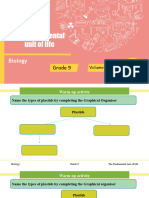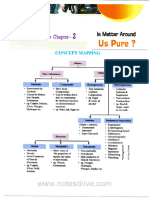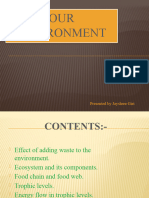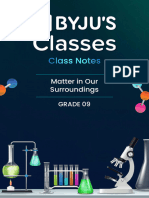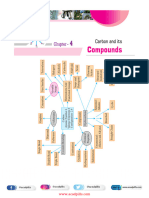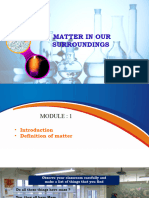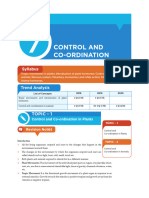Chapter 1 Chemical Reactions and Equations
Chapter 1 Chemical Reactions and Equations
Uploaded by
mangeshhardade01Copyright:
Available Formats
Chapter 1 Chemical Reactions and Equations
Chapter 1 Chemical Reactions and Equations
Uploaded by
mangeshhardade01Original Title
Copyright
Available Formats
Share this document
Did you find this document useful?
Is this content inappropriate?
Copyright:
Available Formats
Chapter 1 Chemical Reactions and Equations
Chapter 1 Chemical Reactions and Equations
Uploaded by
mangeshhardade01Copyright:
Available Formats
SCIENCE
(Chemistry)
Chapter 1: Chemical Reactions and Equations
Drafted by:- Prof. Mangesh Sir -Pune (8766858996)
CHEMICAL REACTIONS AND EQUATIONS
01
Chemical Reactions and Equations
Chemical Reactions: A chemical reaction occurs when one or more reactants (also known
as reactants) are changed into one or more products (also known as products). The
constituent atoms of the reactants are rearranged in a chemical reaction, resulting in the
formation of various substances as products.
A change that results in the formation of one or more new compounds. Chemical changes
are also known as chemical reactions.
• A substance is said to undergo a chemical change when the chemical properties of a
substance alter. As a result, there is either formation or breaking of atomic bonds at the
molecular level. Some characteristics of a chemical change are:
o New substances are produced during a chemical reaction.
o Changes in energy are involved.
o During the reaction, there occurs a change in mass.
o There is a permanent alteration.
Examples:
• Cooking of food
• Rusting of iron
• Heating of Lead nitrate
• Souring of milk
• Ripening of fruit.
Chemical Equation
Drafted by:- Prof. Mangesh Sir -Pune (8766858996) (1)
CHEMICAL REACTIONS AND EQUATIONS
01
Writing Chemical Equations
• In a chemical reaction, the reactants are written on the left hand side and the products
on the right hand side of the equation.
• An arrow (→) pointing towards the products is inserted between the reactants and the
products. It also represents the direction of the reaction.
• A single arrow (→) indicates the direction in which the reaction proceeds.
• A double arrow ( ) indicates a reversible reaction, i.e. the products recombine to form
the reactants.
• A plus sign (+) is inserted between two or more reactants or products formed.
• If reactions are carried out under specific conditions of temperature, pressure, catalyst
etc., then these conditions are mentioned on the arrow.
• The chemical equation can be made more informative by mentioning the physical states
of the reactants and products.
• If gas is liberated as a product, then it is represented by an arrow pointing upwards (↑). If
the product formed is in the form of a precipitate, it is represented by an arrow pointing
downwards (↓).
Balancing the Chemical Equations
• In a balanced chemical equation, the total number of atoms of each element of the
reactants on the left hand side of the equation is equal to the number of atoms of the
products formed on the right hand side of the equation.
• The total mass of the reactants is equal to the total mass of the products or the number
of atoms of each element before the reaction and after the reaction is equal.
Steps Involved in Balancing a Chemical Equation
Consider the chemical reaction between magnesium and oxygen to understand the steps
involved in balancing a chemical equation.
Step 1
Let us first write the word equation for this reaction.
Magnesium + Oxygen → Magnesium oxide
Step 2
Drafted by:- Prof. Mangesh Sir -Pune (8766858996) (2)
CHEMICAL REACTIONS AND EQUATIONS
01
Write the chemical equation for the reaction between magnesium and oxygen.
Mg + O2 → MgO
Step 3
Count the number atoms of an element occurring on both L.H.S. and R.H.S. in this equation.
Mg + O2 → MgO
Component Reactant Product
Magnesium 1 1
Oxygen 2 1
This is an unbalanced equation.
Step 4
• To balance a chemical equation, first draw boxes around each formula. Do not change
anything inside the boxes while balancing the equation.
• Choose a reactant or a product which has the maximum number of atoms in it. In that
compound, select the element which has the maximum number of atoms. In this
equation we shall select MgO i.e. magnesium oxide and the element oxygen in it.
• To balance the oxygen atoms, let us multiply magnesium oxide molecule by 2 on the
right hand side. The equation can now be expressed as,
Component Reactant Product
Magnesium 1 1×2=2
Oxygen 2 1×2=2
Step 5
There are two oxygen atoms on either side of the equation but one magnesium atom on
the reactant's side and two on the product's side. Therefore, multiply the magnesium atom
by 2 on the left hand side.
Component Reactant Product
Magnesium 1×2=2 2
Oxygen 2 2
Balanced equation is,
∴ The number of atoms of each element of reactants = The number of atoms of each
element of products
Step 6
Drafted by:- Prof. Mangesh Sir -Pune (8766858996) (3)
CHEMICAL REACTIONS AND EQUATIONS
01
Writing Specific Conditions on the Arrow
The reaction is carried out in the presence of ‘Heat’. On heating, magnesium combines with
oxygen present in air to form magnesium oxide.
Step 7
Writing Symbols of Physical States
Using these steps, you can balance any chemical equation.
Types of Chemical Reactions
1. Combination Reaction
When two or more substances combine to form a single product, the reaction is known as a
combination reaction.
For example:
In the laboratory, iron sulphide is prepared by mixing iron and sulphur.
Fe(s) + S(s) → FeS(s)
Formation of slaked lime by the reaction of calcium oxide with water
• Endothermic Reaction: The reactions accompanied by the absorption of heat are called
endothermic reactions.
• Exothermic Reaction: The reactions accompanied by the evolution of heat are called
endothermic reactions.
2. Decomposition Reaction
A chemical reaction in which a single compound splits into two or more simple substances
is called a decomposition reaction.
Drafted by:- Prof. Mangesh Sir -Pune (8766858996) (4)
CHEMICAL REACTIONS AND EQUATIONS
01
Correct way of heating the boiling tube containing crystals of ferrous sulphate and of smelling the odour
For example:
When mercuric oxide is heated in a crucible, the orange-red powder begins to darken and a
silver mirror begins to deposit on the cooler parts of the crucible.
• Thermal Decomposition Reaction: The decomposition reactions carried out by heating
are known as thermal decomposition reactions.
• Photochemical reaction: The chemical reactions which proceed with the absorption of
light energy are called photochemical reactions.
3. Displacement Reaction
Reactions in which the more reactive element displaces the less reactive element from its
compound are called displacement reactions.
Iron nails dipped in copper sulphate solution
For example:
Zinc displaces copper in copper sulphate to form zinc sulphate.
4. Double Displacement Reaction
Reactions in which ions of the reactants exchange places to form two new compounds, are
called double displacement reactions.
For example: Sodium hydroxide reacts with hydrochloric acid to form sodium chloride and
water.
NaOH(aq) + HCl(aq) → NaCl(aq) + H2O(l)
Types of Double Displacement Reactions:
A. Precipitation
In all of the following processes, a white material is generated that is insoluble in water.
Drafted by:- Prof. Mangesh Sir -Pune (8766858996) (5)
CHEMICAL REACTIONS AND EQUATIONS
01
A precipitate is the insoluble substance that forms. A precipitation reaction is a reaction
that results in the formation of a precipitate.
B. Neutralization
The reactants are a base and an acid, and the products are salt and water.
Neutralization is a form of double displacement reaction in which the reactants are a
base and an acid, and the products are salt and water. The positive charge of the acid's
hydrogen ion and the negative charge of the base's hydroxyl ions or oxide ions lose their
electrical charge and form covalent water molecules.
Na+OH- + H+Cl- → Na+Cl- + H2O
Base Acid Salt Water
Zn2+O2- + 2H+NO3- → Zn2+(NO3)2- + H2O
A neutralization reaction is basically a reaction between H+ and OHions i.e.,
H+(aq) + OH-(aq) → H2O(l)
5. Oxidation - Reduction Reactions/Redox Reactions
Oxidation and reduction take place simultaneously.
Reactions which involve the addition of oxygen, or the removal of hydrogen are called
oxidation reactions. For example:
C(s) + 2H2 (g) → CH4 (g)
Chemical reactions in which the reactants gain hydrogen are reduction reactions. For
example:
• Oxidation: Substance loses electrons or gains oxygen or loses hydrogen.
• Reduction: Substance gains electrons or loses oxygen or gains hydrogen.
• Oxidising agent: a substance that oxidises another substance and self-gets reduced.
• Reducing agent: a substance that reduces another substance and self-gets oxidised.
Redox Reaction
The chemical reaction in which oxidation and reduction takes place simultaneously is
known as a redox reaction.
Corrosion
Drafted by:- Prof. Mangesh Sir -Pune (8766858996) (6)
CHEMICAL REACTIONS AND EQUATIONS
01
The slow process of decay and destruction of metals due to the action of air, moisture or
acids is called corrosion.
For example:
Iron combines with oxygen present in the air, in the presence of water, to form a red-brown
flaky substance called rust. This process is commonly called the rusting of iron.
The chemical formula of rust is Fe2O3. × H2O.
Prevention of Corrosion
• Corrosion damages buildings, bridges, ships, automobiles and other articles made of
iron. Hence, prevention of corrosion is necessary. This will not only save money but can
also prevent the occurrence of accidents.
• It can be prevented by processes like galvanising and electroplating with other metals.
Rancidity
• Oils and fats react with oxygen and get oxidised or turn rancid. This process is called
rancidity.
• Rancidity can be prevented by keeping food in air tight containers or by using
antioxidants.
• Antioxidants are used to prevent oxidation of food containing fats and oils.
• Storage of food in air tight containers also decelerates oxidation.
Drafted by:- Prof. Mangesh Sir -Pune (8766858996) (7)
CHEMICAL REACTIONS AND EQUATIONS
01
Drafted by:- Prof. Mangesh Sir -Pune (8766858996) (8)
CHEMICAL REACTIONS AND EQUATIONS
01
Important Questions
➢ Multiple Choice Questions:
1. Which of the following is a displacement reaction?
2. Magnesium ribbon is rubbed before burning because it has a coating of
(a) basic magnesium carbonate
(b) basic magnesium oxide
(c) basic magnesium sulphide
(d) basic magnesium chloride
3. Which of the following statements about the given reaction are correct?
3Fe (s) + 4H2O (g) → Fe3O4 (s) + 4 H2 (g)
(i) Iron metal is getting oxidized
(ii) Water is getting reduced
(iii) Water is acting as reducing agent
(iv) Water is acting as oxidizing agent
(a) (i), (zi) and (iii)
(b) (in) and (iv)
(c) (i), (ii) and (iv)
(d) (ii) and (iv)
4. Which of the following are exothermic processes?
(i) Reaction of water with quick lime
(ii) Dilution of an acid
(iii) Evaporation of water
(iv) Sublimation of camphor (crystals)
(a) (i) and (ii)
(b) (ii) and (iii)
(c) (i) and (iv)
(d) (ii) and (iv)
5. Oxidation is a process which involves
(a) addition of oxygen
(b) addition of hydrogen
(c) removal of oxygen
(d) removal of hydrogen
6. The process of reduction involves
(a) addition of oxygen
Drafted by:- Prof. Mangesh Sir -Pune (8766858996) (9)
CHEMICAL REACTIONS AND EQUATIONS
01
(b) addition of hydrogen
(c) removal of oxygen
(d) removal of hydrogen
7. Three beakers labelled as A, B and C each containing 25 ml of water were taken. A
small amount of NaOH, anhydrous CuSO4 and NaCl were added to the beakers A, B
and C respectively. It was observed that there was an increase in the temperature of
the solution contained in beakers A and B, whereas in case of beaker C, the
temperature of the solution falls. Which one of the following statement(s) is (are)
correct?
(i) In beakers A and B, exothermic process has occurred.
(ii) In beakers A and B, endothermic process has occurred.
(iii) In beaker C exothermic process has occurred.
(iv) In beaker C endothermic process has occurred.
(a) (i) only
(b) (ii) only
(c) (i) and (iv)
(d) (iv), (ii) and (iii)
8. Give the ratio in which hydrogen and oxygen are present in water by volume.
(a) 1:2
(b) 1:1
(c) 2:1
(d) 1:8
9. Which among the following statement(s) is (are) true?
Exposure of silver chloride to sunlight for a long duration turns grey due to
(i) the formation of silver by decomposition of silver chloride
(ii) sublimation of silver chloride
(iii decomposition of chlorine gas from silver chloride
(iv) oxidation of silver chloride
(a) (i) only
(b) (i) and (iii)
(c) (ii) and (iii)
(d) (iv) only
10. MnO2 + 4HCl → 2 + 2H2O + Cl2
Identify the substance oxidized in the above equation.
(a) MnCl2
(b) HCl
(c) H2O
(d) MnO2
➢ Very Short Question:
Drafted by:- Prof. Mangesh Sir -Pune (8766858996) (10)
CHEMICAL REACTIONS AND EQUATIONS
01
1. How does the food become rancid?
2. A student burnt a metal A found in the form of ribbon. The ribbon burnt with a
dazzling flame and a white powder B was formed which was basic in nature.
Identify A and B. Write the balanced chemical equation.
3. What is a balanced chemical equation?
4. Write a balanced equation for a chemical reaction that can be characterized as
precipitation.
5. What is rust?
6. A zinc rod is left for nearly 20 minutes in a copper sulphate solution. What change
would you observe in the zinc rod?
7. Name two salts that are used in black and white photography.
8. Which chemical process is used for obtaining a metal from its oxide?
9. If you collect silver coins and copper coins you may have seen that after some
days a black coating forms on silver coins and a green coating on copper coins.
Which chemical phenomenon is responsible for these coatings? Write the
chemical name of the black and green coatings.
10. When carbon dioxide is passed through lime water, it turns milky, why?
➢ Short Questions:
1. You are given the following materials
(i) Marble chips (ii) dilute hydrochloric acid (iii) Zinc granules
Identify the type of reaction when marble chips and zinc granules are added
separately to acid taken in two test tubes.
2. What do you understand by precipitation reaction? Explain with suitable
examples.
3. What happens when aqueous solutions of sodium sulphate and barium chloride
are mixed? What type of reaction is it?
4. Explain the following terms with suitable examples.
(a) Oxidation
(b) Reduction
5. Complete the missing components/variables given as x and y in the following
reactions.
(a) Pb(NO3)2 (aq) + 2Kl (aq) → PbI2 (x) + 2KNO3 (y)
(b) Cu (s) + 2AgNO3 (aq) → Cu(NO3)2 (aq) + x (s)
(c) Zn (s) + H2SO4 (aq) → ZnSO4 (x) + H2 (y)
6. An iron knife kept dipped in a blue copper sulphate solution turns the blue
Drafted by:- Prof. Mangesh Sir -Pune (8766858996) (11)
CHEMICAL REACTIONS AND EQUATIONS
01
solution light green. Why?
7. A, B and C are three elements which undergo chemical reactions in the following
way.
A2O3 + 2B → B2O3 + 2A
3CSO4 + 2B → B2(SO4)3 + 3C
3CO + 2A → A2O3 + 3C
Answer the following:
(a) Which element is most reactive?
(b) Which element is least reactive?
8. Write the balanced chemical equations for the following reactions and identify the
type of reaction in each case.
(a) Nitrogen gas is treated with hydrogen gas in the presence of a catalyst at 773 K to
form ammonia gas.
(b) Sodium hydroxide solution is treated with acetic acid to form sodium acetate and
water.
(c) Ethanol is warmed with ethanoic acid to form ethyl acetate in the presence of
concentrated H2SO4.
(d) Ethene is burnt in the presence of oxygen to form carbon dioxide, water and
releases heat and light.
➢ Long Questions:
1. Balance the following equations:
(a) Bacl2 + H2SO4 → BaSO4 + HCl
(b) CH4 + O2 → CO2 + H2O
2. On heating blue coloured powder of copper (II) nitrate in a boiling tube, copper
oxide (black), oxygen gas and a brown gas X is formed.
(а) Write a balanced chemical equation of the reaction.
(b) Identify the brown gas X evolved.
(c) Identify the type of reaction.
(d) What could be the pH range of aqueous solution of the gas X?
3. (A) Name the type of chemical reaction represented by the following equation:
Drafted by:- Prof. Mangesh Sir -Pune (8766858996) (12)
CHEMICAL REACTIONS AND EQUATIONS
01
(c) Zn(s) + H2SO4(ag) → ZnSO4(aq) + H2(g)
(B) “A solution of potassium chloride when mixed with silver nitrate solution, and an
insoluble white substance is formed”.
(i) Translate the above statement into a chemical equation.
(ii) State two types for the classification of this reaction.
➢ Assertion Reason Questions:
1. For two statements are given-one labelled Assertion (A) and the other labelled Reason
(R). Select the correct answer to these questions from the codes (a), (b), (c) and (d) as
given below:
a. Both A and R are true, and R is correct explanation of the assertion.
b. Both A and R are true, but R is not the correct explanation of the assertion.
c. A is true, but R is false.
d. A is false, but R is true.
Assertion: Silver articles become black after sometime when exposed to sunlight.
Reason: It is because silver reacts with carbonates present in the air.
2. For two statements are given-one labelled Assertion (A) and the other labelled Reason
(R). Select the correct answer to these questions from the codes (a), (b), (c) and (d) as
given below:
a. Both A and R are true, and R is correct explanation of the assertion.
b. Both A and R are true, but R is not the correct explanation of the assertion.
c. A is true, but R is false.
d. A is false, but R is true.
Assertion: A lead nitrate on thermal decomposition gives lead oxide, brown coloured
nitrogen dioxide and oxygen gas.
Reason: Lead nitrate reacts with potassium iodide to form yellow ppt. of lead iodide and
the reaction is double displacement as well as precipitation reaction.
➢ Case Study Questions:
1. Read the following and answer any four questions from (i) to (v).
Oxidation has damaging effect on metals as well as on food. The damaging effect of
oxidation on metal is studied as corrosion and that on food is studied as rancidity. The
phenomenon due to which metals are slowly eaten away by the reaction of air, water
and chemicals present in atmosphere, is called corrosion. For example, iron articles are
shiny when new, but get coated with a reddish-brown powder when left for some time.
This process is known as rusting of iron. Rancidity is the process of slow oxidation of oil
Drafted by:- Prof. Mangesh Sir -Pune (8766858996) (13)
CHEMICAL REACTIONS AND EQUATIONS
01
and fat (which are volatile in nature) present in the food materials resulting in the
change of smell and taste in them.
i. Rancidity can be prevented by:
a. Adding antioxidants.
b. Packaging oily food in nitrogen gas.
c. Both (a) and (b).
d. None of these.
ii. Combination of phosphorus and oxygen is an example of:
a. Oxidation.
b. Reduction.
c. Rancidity.
d. None of these.
iii. A science teacher wrote the following statements about rancidity:
I. When fats and oils are reduced, they become rancid.
II. ln chips packet, rancidity is prevented by oxygen.
III. Rancidity is prevented by adding antioxidants.
Select the correct option.
a. (I) only
b. (II) and (III) only
c. (III) only
d. (I), (II) and (III)
iv. Two statements are given below regarding rusting of iron.
I. The rusting of iron is a redox reaction and reaction occurs as, 4Fe + 3O2 →
4Fe3+ + 6O2-
II. The metallic iron is oxidised to Fe2+ and O2 is reduced to O2-.
Select the correct statement(s).
a. I only.
b. II only.
c. Both I and II.
d. None of these.
v. Which of the following measures can be adopted to prevent or slow down
rancidity?
I. Food materials should be packed in airtight container.
II. Food should be refrigerated.
III. Food materials and cooked food should be kept away from direct sunlight.
a. Only II and III.
b. Only I and III.
c. Only II and III.
Drafted by:- Prof. Mangesh Sir -Pune (8766858996) (14)
CHEMICAL REACTIONS AND EQUATIONS
01
d. I, II and III.
2. Read the following and answer any four questions from (i) to (v).
Chemical equation is a method of representing a chemical reaction with the help of
symbols and formulae of the substances involved in it. ln a chemical equation, the
substances which combine or react are called reactants and new substances produced are
called products. A chemical equation is a shorthand method of representing a chemical
reaction. A balanced chemical equation has equal number of atoms of different elements
in the reactants and products side. An unbalanced chemical equation has unequal number
of atoms of one or more elements in reactants and products. Formulae of elements and
compounds are not changed to balance an equation.
i. Consider the following reaction:
pMg3N2 + qH2O → rMg(OH)2 + sNH3
When the equation is balanced, the coefficients p, q, r, s respectively are:
a. 1, 3, 3, 2
b. 1, 6, 3, 2
c. 1, 2, 3, 2
d. 2, 3, 6, 2
ii. Which of the following information is not conveyed by a balanced chemical equation?
a. Physical states of reactants and products.
b. Symbols and formulae of all the substances involved in a particular reaction.
c. Number of atoms/ molecules of the reactants and products formed.
d. Whether a particular reaction is actually feasible or not.
iii. The balancing of chemical equations is in accordance with:
a. law of combining volumes.
b. law of constant proportions.
c. law of conservation of mass.
d. both (b) and (c).
iv. Which of the following chemical equations is an unbalanced one?
a. 2NaHCO3 → Na2CO3 + H2O + CO2
b. 2C4H10 + 12O2 → 8CO2 + 10H2O
c. 2AI + 6H2O → 2Al(OH)3 + 3H2
d. 4NH3 + 5O2 → 4NO + 6H2O
v. Which of the following statements is/ are correct?
a. A chemical equation tells us about the substances involved in a reaction.
b. A chemical equation informs us about the symbols and formulae of the
substances involved in a reaction.
c. A chemical equation tells us about the atoms or molecules of the reactants and
products involved in a reaction.
d. All the above.
Drafted by:- Prof. Mangesh Sir -Pune (8766858996) (15)
CHEMICAL REACTIONS AND EQUATIONS
01
✓ Answer Key-
➢ Multiple Choice Answers:
1. (b)
2. (a) basic magnesium carbonate
3. (c) (i), (ii) and (iv)
4. (a) (i) and (ii)
5. (a) addition of oxygen
6. (b) addition of hydrogen
7. (c) (i) and (iv)
8. (a) 1 : 2
9. (a) (i) only
10. (d) MnO2
➢ Very Short Answers:
1. Answer: Food becomes rancid when fat and oils present in the food are
oxidized.
2. Answer: X = Mg, Y = MgO, Mg + O2 → 2MgO
3. Answer: An equation that has equal number of atoms of each element on both
the sides of the equation is called a balanced chemical equation, i.e., mass of
the reactants is equal to mass of the products.
4. Answer: BaCl2(aq) + Na2SO4 (aq) → BaSO4(s) + 2NaCl(aq)
5. Answer: It is a brown mass known as hydrated ferric oxide. Its formula is Fe 2O3.
xH2O.
6. Answer: The zinc rod will change into zinc sulphate.
7. Answer: Both silver chloride and silver bromide are used in black and white
photography.
8. Answer: The process is known as the reduction of metal oxide.
9. Answer: Corrosion is responsible for the formation of this coating. Black coating
is due to formation of Ag2S and green coating is due to formation of
CuCO3.Cu(OH)2.
10. Answer: Lime water (calcium hydroxide) combines with carbon dioxide to form
a suspension of calcium carbonate which makes lime water milky.
Ca(OH)2 + CO2 → CaCO3 + H2O
➢ Short Answer:
1. Answer:
Drafted by:- Prof. Mangesh Sir -Pune (8766858996) (16)
CHEMICAL REACTIONS AND EQUATIONS
01
(i) Marble chips react with dilute hydrochloric acid to form calcium chloride and
carbon dioxide. It is a double displacement reaction.
CaCO3 + 2HCl → CaCl2 + H2O + CO2
(ii) Zinc granules react with dilute hydrochloric acid to give hydrogen gas. It is a
displacement reaction.
Zn (s) + 2HCl → ZnCl2 (aq) + H2 (g)
2. Answer:
The reaction in which two compounds in their aqueous state react to form an
insoluble compound. When two reactants react and product formed remains
insoluble and settles as a solid it is substance (precipitate) is called a
precipitation reaction.
For example,
(i) When aqueous solution of sodium sulphate is mixed with an aqueous
solution or barium chloride, barium sulphate is obtained as a white precipitate.
Na2SO4 (aq) + BaCl2 (aq) → BaSO4 (s) + 2NaCl (ag)
(ii) When aqueous solution of sodium chloride is mixed with an aqueous
solution of silver nitrate, silver chloride is obtained as a white precipitate.
3. Answer:
On mixing the solutions of sodium sulphate and barium chloride, a white
precipitate of barium sulphate is obtained.
It is a double displacement reaction.
4. Answer:
(a) Oxidation is a process of addition of oxygen to a substance or removal of
hydrogen from a substance, for example,
Chemical Reactions and Equations Class 10 Extra Questions with Answers
Science Chapter 1, 3
Copper is oxidized to CuO, as oxygen is added to copper.
(b) It is the process of removal of oxygen from a substance or addition of
hydrogen to a substance, for example,
Copper oxide is reduced to copper as it involves removal of oxygen.
5. Answer:
Drafted by:- Prof. Mangesh Sir -Pune (8766858996) (17)
CHEMICAL REACTIONS AND EQUATIONS
01
(a) x = (s), y = (aq)
(b) x = 2Ag
(c) x = (aq); y = (g)
(d) x = heat
6. Answer:
We know that iron is more reactive than copper, so it displaces copper from
copper sulphate solution and forms ferrous sulphate which is of light green
colour.
7. Answer:
(a) The most reactive element is ‘B’. It has displaced both ‘A’ and ‘C’ from their
compounds.
(b) The least reactive element is ‘C’ as it has been displaced by both ‘A’ and ‘B’.
8. Answer:
➢ Long Answer:
1. Answer:
(a) Bacl2 + H2SO4 → BaSO4 + 2HCl
(b) CH4 + 2O2 → CO2 + 2H2O
2. Answer:
Drafted by:- Prof. Mangesh Sir -Pune (8766858996) (18)
CHEMICAL REACTIONS AND EQUATIONS
01
(b) Brown gas X is nitrogen dioxide (NO2).
(c) It is a thermal decomposition reaction.
(d) The gas (NO2) is an oxide of a non-metal. Hence, its aqueous solution will be
acidic, i.e., pH range would be between 0 and 7.
3. Answer:
(A) (a) Decomposition reaction
(b) Combination reaction
(c) Displacement reaction.
(B) (i) KCl (aq) + AgNO3 (aq) → AgCl (s) + KNO3 (aq)
(ii) It is a double displacement reaction also called precipitation reaction.
➢ Assertion Reason Answer:
1. Answer:
c. A is true, but R is false.
Silver reacts with sulphur present in the air and form the layer of silver sulphide
therefore silver articles get tarnished.
2. Answer:
d. Both A and R are true, but R is not the correct explanation of the assertion.
Explanation:
Decomposition reaction is a reaction in which a compound breaks down into two or
more simpler substances.
2Pb(NO3)2 → 2Pb0 + 4NO2 + O2
➢ Case Study Answer:
1. Answer:
i. (c) Both (a) and (b).
Explanation:
Antioxidants and nitrogen gas prevent oxidation of food.
ii. Oxidation.
Explanation:
4P + 302 → 2P2O3
4P + 5O2 → 2P2O5
iii. (c) (III) only
Drafted by:- Prof. Mangesh Sir -Pune (8766858996) (19)
CHEMICAL REACTIONS AND EQUATIONS
01
Explanation:
The oils and fats are slowly oxidised to certain bad smelling compounds, which
release foul smell. This is known as rancidity. Rancidity is prevented by filling
nitrogen gas in chips packets.
iv. Only II and III.
v. (d) I, II and III.
2. Answer:
i. (b) 1, 6, 3, 2
Explanation:
Mg3N2 + 6H2O- 3Mg(OH)2 + 2NH3
i. (d) Whether a particular reaction is actually feasible or not.
ii. (c) law of conservation of mass.
Explanation:
ln a balanced chemical equation, total mass of reactants must be equal to the total mass
of products. This is the statement of law of conservation of mass.
iv. (b) 2C4H10 + 12O2 → 8CO2 + 10H2O
v. (d) All the above.
Drafted by:- Prof. Mangesh Sir -Pune (8766858996) (20)
You might also like
- Geography Notes Form 4Document104 pagesGeography Notes Form 4Gift Simau100% (2)
- 1 Chemical Reaction and Equation 1Document27 pages1 Chemical Reaction and Equation 1Amit Kumar LalNo ratings yet
- Hindi Atoms & Molecules in One Shot AnubhaDocument112 pagesHindi Atoms & Molecules in One Shot AnubhaDushyant SinghNo ratings yet
- Chapter2 CarboncompoundsDocument71 pagesChapter2 CarboncompoundsJachinta JuliusNo ratings yet
- Chapter 3 - Metals & Non MetalsDocument47 pagesChapter 3 - Metals & Non MetalsRoberto Peris100% (1)
- Chemistry - Acids, Bases and Salts - Class NotesDocument70 pagesChemistry - Acids, Bases and Salts - Class Notesabhinavsinghbaliyanraghuvanshi100% (1)
- Chemical BondingDocument37 pagesChemical BondingJenifer TaniaNo ratings yet
- ATOMS AND MOLECULE Class 9 ChemistryDocument52 pagesATOMS AND MOLECULE Class 9 Chemistryalkaprashant1006No ratings yet
- CH 3 Chemistry - Metals and Non Metals - Class NotesDocument126 pagesCH 3 Chemistry - Metals and Non Metals - Class NotesAyush100% (1)
- CBSE Class 9 Science Chap 3 - Atoms and Molecules - Revision NotesDocument12 pagesCBSE Class 9 Science Chap 3 - Atoms and Molecules - Revision Notessadhu associatesNo ratings yet
- MATTER (1.1 Atoms and Molecules)Document43 pagesMATTER (1.1 Atoms and Molecules)Eroll MirulNo ratings yet
- Carbon & It's Compound Class 10Document76 pagesCarbon & It's Compound Class 10rk1611935No ratings yet
- Chapter 3 Atoms and MoleculesDocument19 pagesChapter 3 Atoms and MoleculesRAJIV SHARMANo ratings yet
- Chapter 2 Acids Bases and SaltsDocument24 pagesChapter 2 Acids Bases and Saltsmangeshhardade01No ratings yet
- Is Matter Around Us Pure NotesjhDocument16 pagesIs Matter Around Us Pure NotesjhMohitNo ratings yet
- Chem Grade 9 Vol 1 Science Matter in Our Surrounding 2022-23 LP 2 PPT QcedDocument21 pagesChem Grade 9 Vol 1 Science Matter in Our Surrounding 2022-23 LP 2 PPT Qcedyashika.nirmal2010No ratings yet
- Carbon and Its Compoundsb67Document16 pagesCarbon and Its Compoundsb67devofo2376No ratings yet
- Chapter 2 ChemistryDocument10 pagesChapter 2 ChemistrySuchita JhaNo ratings yet
- Control and CoordinationDocument41 pagesControl and CoordinationSK ABDUR REHMAN (SK)No ratings yet
- CLASS 10thDocument39 pagesCLASS 10thReenu VarshneyNo ratings yet
- Chapter 4Document27 pagesChapter 4Mohsin ahmedNo ratings yet
- Chapter 8 MotionDocument16 pagesChapter 8 MotionSagarika MishraNo ratings yet
- CH 4 - Carbon and CompoundsDocument53 pagesCH 4 - Carbon and CompoundsSJ ClassesNo ratings yet
- Grade 9 Science SummaryDocument38 pagesGrade 9 Science SummaryMauliNo ratings yet
- Acids Bases and SaltsDocument21 pagesAcids Bases and Saltsavishi100% (1)
- Atoms and MoleculesDocument30 pagesAtoms and MoleculesChristine AlmeidaNo ratings yet
- Our Environment 3Document11 pagesOur Environment 3Vishal DeyNo ratings yet
- 23NFOUN09CHE01 - Matter in Our Surroundings - NOTESDocument78 pages23NFOUN09CHE01 - Matter in Our Surroundings - NOTESkrishnanivedha2No ratings yet
- Previouspapers-Apdsc2018-Pgt Psy Science 29 12 18 s1Document75 pagesPreviouspapers-Apdsc2018-Pgt Psy Science 29 12 18 s1Lisha ShanviNo ratings yet
- 4.structure of AtomDocument9 pages4.structure of Atomdnbabu4No ratings yet
- Metal and Non MetalDocument11 pagesMetal and Non MetalrudrampareekNo ratings yet
- CH-2 Acid Bases and SaltsDocument149 pagesCH-2 Acid Bases and Saltstanayarora5890No ratings yet
- Structure of Atom.Document18 pagesStructure of Atom.Fozia ShaikhNo ratings yet
- CH-5 Life ProcessesDocument169 pagesCH-5 Life Processestanayarora5890No ratings yet
- (L1) Carbon and Its Compounds Class10Document22 pages(L1) Carbon and Its Compounds Class10Rekha Mishra0% (1)
- Acids Bases and SaltsDocument18 pagesAcids Bases and Saltsollaabdelrahman09100% (1)
- Acids, Bases and SaltsDocument34 pagesAcids, Bases and SaltsLakshan Fernando100% (1)
- 2 EnvironmentDocument25 pages2 EnvironmentSAGAR BISWALNo ratings yet
- Carbon Compounds and Covalent BondingDocument15 pagesCarbon Compounds and Covalent BondingRajeevv KalraNo ratings yet
- 4 Structure OftheatomDocument15 pages4 Structure OftheatomVaibhav V VeenajNo ratings yet
- Bio Grade 9 Vol 1 Science The Fundamental Unit of Life 2022-23 LP 10Document15 pagesBio Grade 9 Vol 1 Science The Fundamental Unit of Life 2022-23 LP 10yashika.nirmal2010No ratings yet
- Biology Holidays HomeworkDocument13 pagesBiology Holidays HomeworkKeshvi AggarwalNo ratings yet
- Chapter 2 Is Matter Around Us Pure NotesDocument16 pagesChapter 2 Is Matter Around Us Pure NotesManjusha MathewNo ratings yet
- Chapter 4 Cabon and Its CompoundsDocument54 pagesChapter 4 Cabon and Its Compoundsrohitbhatt0508No ratings yet
- Structure of AtomsDocument26 pagesStructure of AtomsdhruvindharmendraNo ratings yet
- Acids FinalDocument66 pagesAcids FinalrehanbandenawazdhalayitNo ratings yet
- Our EnvironmentDocument15 pagesOur Environmentjayshreegiri1718No ratings yet
- MetalsDocument39 pagesMetalsEula YaoNo ratings yet
- Matter in Our Surroundings - NotesDocument18 pagesMatter in Our Surroundings - NotesRajveer KaushalNo ratings yet
- Carbon and Its Compounds L-3 - Class 10Document23 pagesCarbon and Its Compounds L-3 - Class 10sabarikrishnNo ratings yet
- Life Processes Lec - 1Document43 pagesLife Processes Lec - 1Pooja RohillaNo ratings yet
- Carbon and Its CompoundsDocument19 pagesCarbon and Its CompoundsARNAV DEYNo ratings yet
- Control and CoordinationDocument104 pagesControl and CoordinationNavya SharmaNo ratings yet
- Motion Class 9 PPT Dav CMCDocument39 pagesMotion Class 9 PPT Dav CMCbipsmailboxNo ratings yet
- Life ProcessesDocument18 pagesLife ProcessesM. RajNo ratings yet
- Metals and Non MetalsDocument72 pagesMetals and Non Metalssimone100% (1)
- Chapter - 1 - Matter in Our Surrondings - NewDocument73 pagesChapter - 1 - Matter in Our Surrondings - NewRashmi GuptaNo ratings yet
- Control and Co-OrdinationDocument20 pagesControl and Co-OrdinationAnisha ThomasNo ratings yet
- IGCSE ElectricityDocument27 pagesIGCSE Electricitychannyeinkhant11No ratings yet
- Electricity (U-1)Document65 pagesElectricity (U-1)dancelikeangelNo ratings yet
- Class-10-Science-Chemical Reactions and EquationsDocument21 pagesClass-10-Science-Chemical Reactions and EquationsweblaunchindiaNo ratings yet
- Tori SimaDocument2 pagesTori SimaSeptriani LaoliNo ratings yet
- 1-AE-302-Introduction Engg HydrologyDocument36 pages1-AE-302-Introduction Engg HydrologyMuhammad Ibrar Akbar Ali JanNo ratings yet
- Amega BookDocument8 pagesAmega BookmrajisNo ratings yet
- Structured WaterDocument51 pagesStructured WaterGEORGIOS ANTONIOU100% (4)
- PowerPlantwk1 13Document174 pagesPowerPlantwk1 13dub.ivandridilagNo ratings yet
- Phenolic Resin - BrosurDocument53 pagesPhenolic Resin - BrosurpaimannNo ratings yet
- Indo Green (M) - Rev 14-12-2016 PDFDocument4 pagesIndo Green (M) - Rev 14-12-2016 PDFarjun 11No ratings yet
- Tut2004 G4HDocument3 pagesTut2004 G4HAbdiwali Y. Dhoof93% (14)
- Flexotherm Operating Manual 0020213396 02 1043819Document20 pagesFlexotherm Operating Manual 0020213396 02 1043819stefan.dragos93No ratings yet
- EIA Report NMDC Bachelie BPDocument596 pagesEIA Report NMDC Bachelie BPkselvan_1No ratings yet
- 2.3 Design of Hydrometeorological Data NetworksDocument13 pages2.3 Design of Hydrometeorological Data NetworksravishnkNo ratings yet
- Cosmonate LLDocument3 pagesCosmonate LLGİZEM DEMİRNo ratings yet
- Earth Sci Unit 3Document4 pagesEarth Sci Unit 3KhrysNo ratings yet
- Grd. Flr. Wastewater Piping Layout 2Nd. Flr. Wastewater Piping LayoutDocument1 pageGrd. Flr. Wastewater Piping Layout 2Nd. Flr. Wastewater Piping LayoutBess Adrane JurolanNo ratings yet
- Thermodynamic Analysis of A Vapor Absorption System Using Modified Gouy Stodola EquationDocument6 pagesThermodynamic Analysis of A Vapor Absorption System Using Modified Gouy Stodola EquationSuraj ShindeNo ratings yet
- Automatic Control of Production of Balsam-Based Shampoo BatchesDocument11 pagesAutomatic Control of Production of Balsam-Based Shampoo BatchesMiguel Yepes TamayoNo ratings yet
- NZEB Brochure 150Document84 pagesNZEB Brochure 150MichaelPurcellNo ratings yet
- Klargester Percolation Test MethodDocument2 pagesKlargester Percolation Test MethodDoug WeirNo ratings yet
- Personal: Specific Uses and Therapies of The Various Kangen WatersDocument8 pagesPersonal: Specific Uses and Therapies of The Various Kangen WatersKazi Mohammed100% (1)
- Geography Third ExaminationDocument8 pagesGeography Third ExaminationTijani Basit Abiodun100% (1)
- VGB-S-042!00!2018-01-En Chemical Feeding and Feed Systems For Water-Steam Circuits (Ebook LICENSE-VGB-OM)Document84 pagesVGB-S-042!00!2018-01-En Chemical Feeding and Feed Systems For Water-Steam Circuits (Ebook LICENSE-VGB-OM)Matea MalovrhNo ratings yet
- ReportDocument10 pagesReportVangelyn ManguiranNo ratings yet
- FAO Report On GROUNDNUT OIL PDFDocument16 pagesFAO Report On GROUNDNUT OIL PDFVIRTU 8 HR & IT LLPNo ratings yet
- 6 44 0005 Rev5 PDFDocument439 pages6 44 0005 Rev5 PDFprasadNo ratings yet
- Classification of Hydroelectric Power PlantsDocument6 pagesClassification of Hydroelectric Power PlantsMohammed Zoheb nawaz Civil Asst.profNo ratings yet
- Our Common Future - From One Earth To One World - A - 42 - 427 Annex, Overview - UN Documents - Gathering A Body of Global AgreementsDocument16 pagesOur Common Future - From One Earth To One World - A - 42 - 427 Annex, Overview - UN Documents - Gathering A Body of Global AgreementsNITUL BORAHNo ratings yet
- Spec Booklet Complete PDFDocument276 pagesSpec Booklet Complete PDFresellana5893No ratings yet
- Estimatte PL 1Document2 pagesEstimatte PL 1Fritz NatividadNo ratings yet
- Research Paper On Alternative Solar Cell and Its ApplicationDocument4 pagesResearch Paper On Alternative Solar Cell and Its ApplicationerpublicationNo ratings yet



